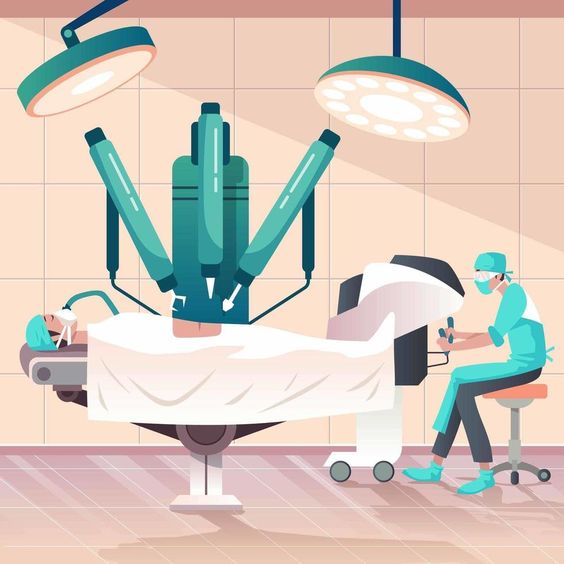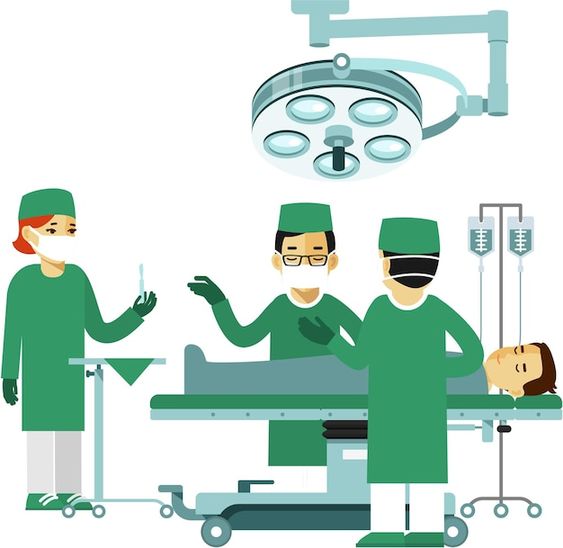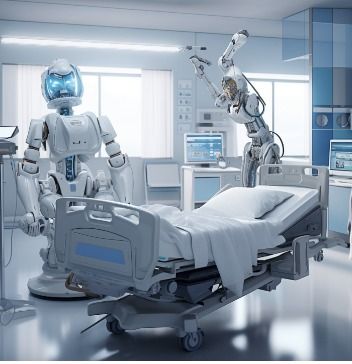
Table of Contents
Meta Description
Robotics in Nursing: Will Robots Replace Nurses?
The global healthcare robotics market is predicted to reach a staggering $40 billion by 2026, signaling a transformative shift in the delivery of patient care. Robotics in Nursing is no longer a futuristic concept; it’s rapidly becoming a reality, with robots taking on tasks traditionally performed by nurses, from medication dispensing to patient monitoring. While this integration offers exciting possibilities for enhanced efficiency and patient outcomes, it also challenges the nursing profession. This article delves into the evolving landscape of nursing in the age of robotics, analyzing both the opportunities and disruptions this technological revolution brings. We’ll examine the concerns surrounding job displacement and the need for new skills while highlighting how robotics in nursing can empower nurses to focus on higher level care and strengthen the human connection at the heart of nursing.
Robots on the Rise: The Changing Landscape of Nursing
The integration of robotics in nursing is not a sudden phenomenon but rather a gradual evolution, with roots tracing back several decades. The first significant foray of robots into healthcare was in the realm of surgery. In the late 1990s and early 2000s, robotic-assisted surgery gained traction, offering surgeons greater precision and control during complex procedures. These early surgical robots paved the way for the broader acceptance of robotics in healthcare, demonstrating the potential for technology to enhance medical practices.
Today, the types of robots entering the nursing domain extend far beyond the operating room. Delivery robots are now commonplace in many hospitals, autonomously navigating hallways to transport medications, lab samples, and supplies, freeing nurses from time-consuming logistical tasks. Telepresence robots enable remote consultations with specialists, bringing expert care to patients in underserved areas. Armed with UV light technology, disinfection robots enhance infection control by autonomously disinfecting rooms and equipment, contributing to a safer hospital environment. Assistive robots are emerging as helpful partners in patient care, providing mobility support, assisting with hygiene, and even offering medication reminders.
Automating traditional nursing tasks is perhaps the most significant impact of robots on the nursing profession. Robots are efficiently managing tasks that were once solely the responsibility of nurses. Medication dispensing robots ensure accurate and timely medication delivery, reducing the risk of errors. Robots equipped with sensors can monitor vital signs, alerting nurses to any significant changes in a patient’s condition. Automated systems can collect and transport lab specimens, streamlining the diagnostic process. Even patient transport within a hospital is being facilitated by robots, allowing nurses to focus on direct patient care rather than logistical duties.
Real-world examples demonstrate the positive impact of robots on nursing workflows. Hospitals like the University of California and San Francisco Medical Center have successfully implemented robotic systems for medication dispensing, reporting improved accuracy and efficiency. The University of Texas MD Anderson Cancer Center uses robots for lab specimen delivery, reducing turnaround times and improving workflow efficiency. These examples highlight how robots are not replacing nurses but acting as valuable tools, optimizing workflows, and freeing nurses to focus on the human-centric aspects of patient care.
Challenges with Robotics in Nursing: Navigating the Potential Disruptions

While promising, the rise of robotics in nursing also presents significant challenges that must be navigated thoughtfully to ensure a smooth transition and optimal patient care. One of the most prominent concerns is the potential for job displacement. The fear that robots will render nurses redundant is valid, as automation inevitably changes the nature of many traditional nursing tasks. However, it’s important to remember that history has shown that technological advancements often lead to new jobs and opportunities. Integrating robotics in nursing will likely create new roles requiring specialized skills in operating, managing, and collaborating with robots. Nurses will be needed to oversee robot functionality, educate patients on interacting with robots, and address any ethical or technical challenges that may arise.
This leads to the next challenge: the skills gap. Nurses must have the knowledge and skills to thrive in a robot-integrated healthcare environment. This requires a shift in nursing education, integrating robotics training into curricula and providing continuous professional development opportunities for practicing nurses. Nurses need to be comfortable operating robots, interpreting data generated by robots, and understanding the limitations and capabilities of this technology. This ongoing education will be crucial in bridging the skills gap and ensuring nurses remain valuable contributors to patient care.
Ethical considerations also come to the forefront with the increasing use of robots in healthcare. Patient privacy and data security are paramount when robots collect and analyze patient information. Clear protocols and safeguards must be in place to ensure responsible data handling and prevent breaches. Additionally, the potential for algorithmic bias in robots making decisions about patient care must be addressed. Rigorous testing and continuous monitoring of robotic systems are essential to ensure equitable and unbiased decision-making that prioritizes patient well-being.
Perhaps the most significant challenge is maintaining the human touch in a technologically advanced healthcare environment. Robots, for all their capabilities, cannot replace the essential human elements of nursing. Empathy, compassion, critical thinking, and complex decision-making are qualities that remain uniquely human. Nurses excel at building trust, providing emotional support, and advocating for their patients’ needs. These aspects of care require strong interpersonal skills, intuitive understanding, and a level of human connection that robots cannot replicate. It’s vital that while embracing robotics in nursing, we also emphasize the importance of nurses maintaining these core strengths and continuing to provide holistic care that addresses their patients’ physical and emotional needs. The future of nursing lies in leveraging the power of robotics while preserving the irreplaceable human connection that lies at the heart of compassionate care.
Opportunities: Empowering Nurses for the Future

While robotics in nursing presents challenges, it also opens up exciting opportunities to enhance patient care and empower nurses in their roles. One of the most significant opportunities is the shift toward higher-level patient care. Robots are incredibly efficient at performing routine, time-consuming tasks like medication dispensing, vital sign monitoring, and specimen collection. By taking on these tasks, robots allow nurses to focus on more complex patient needs requiring critical thinking, nuanced judgment, and a human touch.
This shift allows nurses to dedicate more time to patient education, providing personalized guidance and support to help patients understand their conditions and treatment plans. It enables them to offer emotional support, build stronger relationships with patients, and address their anxieties and concerns. Additionally, nurses gain more time for care coordination, collaborating with other healthcare professionals to ensure patients receive holistic and integrated care. By offloading routine tasks to robots, nurses are empowered to practice at the top of their license, focusing on the aspects of care where their skills and compassion are most impactful.
Furthermore, robots can be valuable partners for nurses, enhancing efficiency and collaboration. Robots with advanced sensors and data analysis capabilities can collect and process vast amounts of patient information, providing nurses with real-time insights into patient conditions and trends. This data empowers nurses to make more informed decisions, personalize care plans, and intervene proactively to prevent complications. Telepresence robots can facilitate seamless communication between healthcare providers, allowing for remote consultations, faster diagnoses, and more coordinated care delivery.
Integrating robots into healthcare also creates exciting new roles and career paths for nurses. The role of a “Robot Coordinator” or “Robotics Specialist” is emerging, focusing on managing and maintaining a hospital’s robot fleet, overseeing training programs, and troubleshooting any technical issues. Nurses with a strong understanding of clinical practice and robotics will be highly sought after for these roles. These new career paths offer professional growth, specialization, and leadership opportunities within a technologically advanced healthcare system.
To prepare for this future, nursing education needs to adapt. Integrating robotics education into nursing curricula is essential to equip future nurses with the skills and knowledge to thrive in a robot-integrated environment. This includes training on operating robots, interpreting robot-generated data, and understanding the ethical considerations of using robots in healthcare. Lifelong learning and continuing education will also be vital, ensuring nurses stay abreast of the latest advancements in robotics and adapt to the ever-evolving landscape of healthcare technology. By embracing these opportunities, nurses can harness the power of robotics to enhance their skills, expand their roles, and continue to provide compassionate, patient-centered care in the future.
Conclusion: A Future of Collaboration and Enhanced Care
Integrating robotics in nursing is undeniably transformative, reshaping the profession in exciting and challenging ways. While concerns about job displacement and the need for new skills are valid, the potential for robots to enhance patient care and empower nurses is undeniable. The future of nursing is not about being replaced by robots but about embracing technology as a powerful tool to optimize workflows, improve efficiency, and allow nurses to practice at the top of their license.
Robots are not taking over; they are stepping in to handle routine tasks, freeing nurses to focus on the irreplaceable human elements of care empathy, critical thinking, patient advocacy, and building trusting relationships. By collaborating with robots, nurses can dedicate more time to providing personalized education, emotional support, and complex care coordination, ultimately elevating the quality of care delivered to each patient. This collaborative approach leverages the strengths of both humans and robots, creating a synergistic partnership where technology enhances, not diminishes, the essential role of the nurse.
The key to navigating this technological shift lies in adaptation and lifelong learning. Nurses must embrace new technologies, continually expand their skills, and remain flexible in evolving roles. Integrating robotics in nursing education is crucial to equip future nurses with the knowledge and expertise they need to thrive in a technologically advanced healthcare environment.
As we look toward the future, we envision a healthcare landscape where robots and nurses work together, each contributing their unique strengths to provide exceptional patient care. Technology will empower nurses, not replace them, allowing them to focus on the human connection, compassion, and expert care that define the heart of nursing. This collaborative future holds immense promise for enhancing patient outcomes, improving workplace efficiency, and strengthening the nursing profession.
Are you ready to embrace the future of nursing?
This is just a glimpse into the fascinating world of robotics in nursing. To dive deeper into this topic and explore the latest research, innovations, and career opportunities, visit Nursingpapers. This comprehensive resource offers a wealth of information for aspiring nurses, including:
- In-depth articles and research papers on the latest advancements in robotics in nursing.
- Expert insights and perspectives on the evolving role of nurses in a technologically advanced healthcare system.
- Resources and tools to help you develop the skills and knowledge needed to thrive in the future of nursing.
Don’t get left behind empower yourself with knowledge and prepare for the exciting future of nursing at Nursingpapers.







